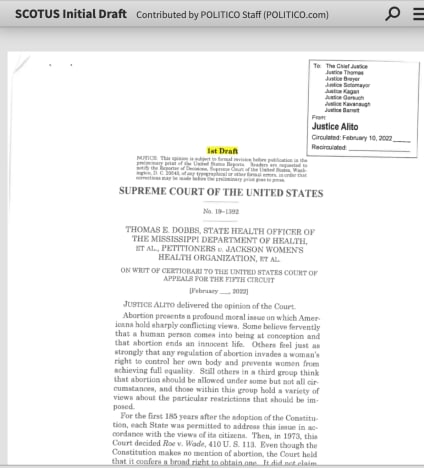As you’ve likely heard by now, a draft of a Supreme Court majority decision indicating that the justices intend to overturn Roe v. Wade was leaked to the public on Monday night.
The opinion — penned by Justice Samuel Alito — is not yet official, but the steps that remain for the initial vote to become a final ruling are likely a mere formality.
That means that tens of millions of American women will effectively be stripped of their reproductive rights, as laws governing privacy and abortion will now be left up to individual states, which can essentially do as they please with little consideration for the will of the people.
If you’re feeling frightened and confused at the moment, you’re certainly not alone.
Sadly, we can’t do much to alleviate your fears, but we can help to clear up some of the confusion regarding this unexpected and hugely impactful development.
Information is often the best antidote to anxiety, so here’s a brief rundown on what happened, what it means, and what to expect.
The Leak: We’ll start with the aspect of this story that we know the least about — namely, the manner in which the court’s decision was made public.
Alito’s opinion was written several months ago and leaked to the website Politico by an unknown insider earlier this week.
Not surpsiringly, the court was divided on this matter, with five justices voting to overturn Roe and Planned Parenthood v. Casey, three votes against, and Chief Justice John Roberts in the middle.
In the past, decisions have changed between the initial vote and the final ruling, but such reversals are rare.
It’s worth pointing out that the court changed its mind on the original Planned Parenthood v. Casey decision, with Justice Anthony Kennedy writing the decision to uphold reproductive rights after initially voting to overturn Roe v. Wade.
A recent Wall Street Journal piece indicated that Justice Roberts is “trying to turn” his conservative colleagues toward a more moderate ruling.
The leak might have been part of a conservative campaign to thwart that effort.
What The Decision Means: In addition to the decades-long battle over a woman’s right to choose, this is also the latest chapter in the never-ending story of the conservative push for states’ rights.
You might remember that phrase as one used by historical revisionists to justify the Confederacy’s cause in the Civil War.
These days, it’s being deployed for similar purposes — an excuse to subvert the will of the people and conceal one party’s true intentions.
Yes, the Roe reversal would leave the decision up to the states, but for millions of disproportionately POC and lower-class Americans, that would mean their access to proper reproductive care is restricted to the point of being non-existent.
What Can You Do: One of the most controversial aspects of the Supreme Court is the fact that a tremendous amount of power rests in the hands of just nine people, all of whom are appointed, not elected.
Not only that, these are lifetime appointments, which means that the makeup of the Court is subject to the whims of fate.
Donald Trump made three appointments during his one term in office, which is more than Obama made during his two terms (the Republican-led Congress blocked Obama’s nomination of current attorney general Merrick Garland for petty, capricious reasons).
Clarence Thomas was appointed during the presidency of George H.W. Bush, which ended before most of the people reading this article were even born.
The knowledge that a body over which voters have no direct control is in charge of making such important decisions can be frustrating, but it’s important to remember that you’re not powerless:
On social media, and at the local, grassroots level, groups are organizing with the goal of protesting and contacting members of Congress to implore them to take action to codify abortion rights as federal law.
If you’re in a position to do so, you can also donate to Planned Parenthood and other organizations that help ensure the reproductive rights of all people.
And of course, you can reach out to others who might be sharing your concerns.
It may not seem like much, but at times like this, there’s strength and safety in numbers, and you might be able to offer support to someone who has little else.
Source: Read Full Article









